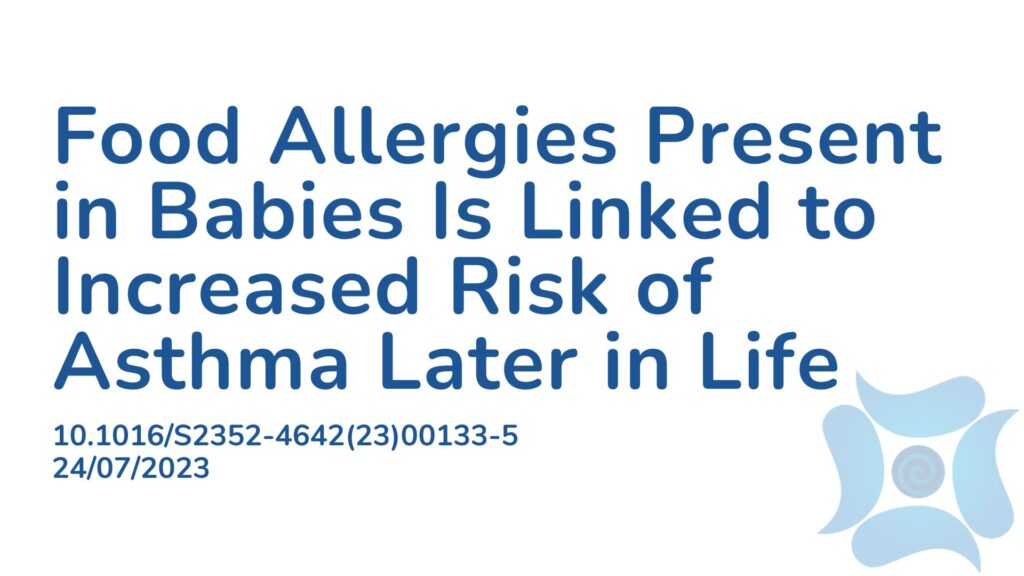Summary:
This Australian research has found that there is a link between food allergies that are present as a baby and an increased risk of both asthma and poorer lung health later in life. The researchers recruited 5,276 infants who were tested for common food allergens such as peanuts and egg and then followed their health journey till the age of six. The study found that by the age of six, the children with food allergies as a baby were almost four times more likely to develop asthma, when compared to the children without food allergies as a baby. Children with a food allergy as a baby were also more likely to have reduced lung function. This paper reveals that food allergies that are present in babies is associated with poorer respiratory health in children once they reach the age of six.
Abstract:
Background: Food allergy is considered a precursor to asthma in the context of the atopic march, but the relationship between infant food allergy phenotypes and lung function and asthma in childhood is unclear. We aimed to examine the association between food sensitisation and challenge-confirmed food allergy in infancy, as well as persistent and resolved food allergy up to age 6 years, and the risk of lung function deficits and asthma at age 6 years. Methods: The longitudinal, population-based HealthNuts cohort study in Melbourne, VIC, Australia, recruited 5276 infants children aged 1 year who attended council-run immunisation sessions between Sept 28, 2007, and Aug 5, 2011. At age 1 year, all children completed skin prick testing to four food allergens (egg, peanut, sesame, and either shrimp or cow’s milk) and an oral food challenge (egg, peanut, and sesame) at the Royal Children’s Hospital in Melbourne. Parents completed questionnaires about their infant’s allergy history, demographic characteristics, and environmental exposures. At age 6 years, children were invited for a health assessment that included skin prick testing for ten foods (milk, egg, peanut, wheat, sesame, soy, shrimp, cashew, almond, and hazelnut) and eight aeroallergens (alternaria, cladasporum, house dust mite, cat hair, dog hair, bermuda grass, rye grass, and birch mix), oral food challenges, and lung function testing by spirometry. Questionnaires completed by parents (different to those completed at age 1 year) captured the child’s allergy and respiratory history and demographics. We investigated associations between food allergy phenotypes (food-sensitised tolerance or food allergy; and ever, transient, persistent, or late-onset food allergy), lung function spirometry measures (forced expiratory volume in 1 sec [FEV1] and forced vital capacity [FVC] z-scores, FEV1/FVC ratio, forced expiratory flow at 25% and 75% of the pulmonary volume [FEF25-75%], and bronchodilator responsiveness), and asthma using regression methods. Only children with complete data on the exposure, outcome, and confounders were included in models. Infants without food sensitisation or food allergy at age 1 year and 6 years served as the reference group. Findings: Of 5276 participants, 3233 completed the health assessment at age 6 years and were included in this analysis. Food allergy, but not food-sensitised tolerance, at age 1 year was associated with reduced FEV1 and FVC (aβ -0·19 [95% CI -0·32 to -0·06] and -0·17 [-0·31 to -0·04], respectively) at age 6 years. Transient egg allergy was associated with reduced FEV1 and FVC compared with never having egg allergy (-0·18 [95% CI -0·33 to -0·03] and -0·15 [-0·31 to 0·00], respectively), whereas persistent egg allergy was not (FEV1 -0·09 [-0·48 to 0·31]; FVC -0·20 [-0·62 to 0·21]). Transient peanut allergy was associated with reduced FEV1 and FVC (FEV1 aβ -0·37 [-0·79 to 0·04] and FVC aβ -0·55 [-0·98 to -0·12]), in addition to persistent peanut allergy (FEV1 aβ -0·30 [-0·54 to -0·06] and FVC aβ-0·30 [-0·55 to -0·05]), and late-onset peanut allergy (FEV1 aβ -0·62 [-1·06 to -0·18] and FVC aβ-0·49 [-0·96 to -0·03]). Estimates suggested that food-sensitised tolerance and food allergy were associated with reduced FEF25-75%, although some estimates were imprecise. Food allergy phenotypes were not associated with an FEV1/FVC ratio. Late-onset peanut allergy was the only allergy phenotype that was possibly associated with increased risk of bronchodilator responsiveness (2·95 [95% CI 0·77 to 11·38]). 430 (13·7%) of 3135 children were diagnosed with asthma before age 6 years (95% CI 12·5-15·0). Both food-sensitised tolerance and food allergy at age 1 year were associated with increased asthma risk at age 6 years (adjusted odds ratio 1·97 [95% CI 1·23 to 3·15] and 3·69 [2·81 to 4·85], respectively). Persistent and late-onset peanut allergy were associated with higher asthma risk (3·87 [2·39 to 6·26] and 5·06 [2·15 to 11·90], respectively). Interpretation: Food allergy in infancy, whether it resolves or not, is associated with lung function deficits and asthma at age 6 years. Follow-up studies of interventions to prevent food allergy present an opportunity to examine whether preventing these food allergies improves respiratory health. Funding: National Health & Medical Research Council of Australia, Ilhan Food Allergy Foundation, AnaphylaxiStop, the Charles and Sylvia Viertel Medical Research Foundation, the Victorian Government’s Operational Infrastructure Support Program.
Article Publication Date: 24/07/2023
DOI: 10.1016/S2352-4642(23)00133-5




